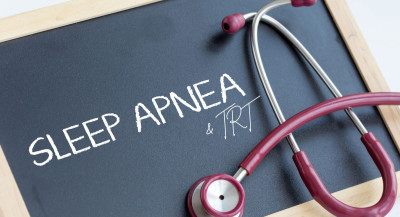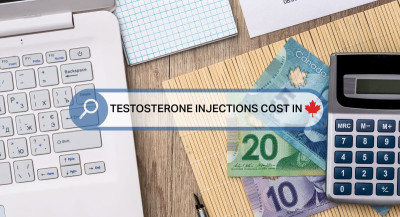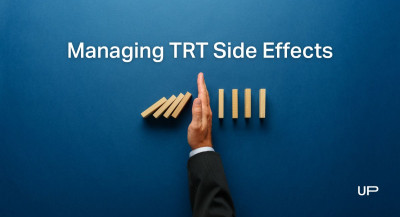What Are Normal Testosterone Levels By Age?


Testosterone plays a major role in men’s energy, mood, muscle mass, and sexual function. So when levels drop, it’s no surprise that many start wondering what’s considered “normal” and whether they need help.

The truth is, testosterone levels naturally decline with age, but the pace and impact vary from person to person.
Understanding how testosterone typically changes over time helps men spot when something’s off and whether it’s time to get tested. For those showing symptoms of low T, options like testosterone replacement therapy (TRT) in Canada are available, but it all starts with knowing where your numbers stand.
Topics covered in this article:
- Total vs Free Testosterone Explained
- Normal Testosterone Levels by Age
- When Is Low Testosterone Diagnosed?
- What Causes Testosterone to Drop?
- When to Get Tested
- TRT as a Treatment Option
- UPGUYS Support for Men in Canada
- Conclusion: Know Your Numbers, Know Your Options
- Frequently Asked Questions (FAQs)
- References
Total vs Free Testosterone Explained
When checking testosterone levels, it's important to understand the difference between total and free testosterone.

- Total testosterone measures the overall amount of testosterone in your blood, including both bound and unbound (free) forms.
- Free testosterone refers specifically to the small fraction of testosterone that circulates unbound and is biologically active.
Most testosterone in your body is bound to proteins like sex hormone-binding globulin (SHBG) or albumin, making it unavailable to interact with cells. Free testosterone, however, can enter cells and directly influence things like mood, libido, muscle strength, and energy.
Doctors often test total testosterone first, but if your symptoms don’t match the result, they may also check free testosterone to get a clearer picture. Both numbers together help determine if testosterone replacement therapy (TRT) in Canada is appropriate.
Normal Testosterone Levels by Age
While general reference ranges exist, it's important to note that exact values may vary slightly depending on the lab and testing methods used. Always interpret results in context with your healthcare provider.
Here’s a general overview of total testosterone levels by age:
These numbers reflect broad averages, not strict cutoffs. Some men in their 60s may feel great with levels around 400 ng/dL, while others in their 30s may feel symptoms of low testosterone at 450 ng/dL.
Because of this, Canadian healthcare providers often look at both lab results and symptoms before recommending testosterone replacement therapy (TRT) in Canada. Context matters more than a single number.
When Is Low Testosterone Diagnosed?
Doctors typically diagnose low testosterone, or hypogonadism, when blood levels fall below established lab thresholds and symptoms are present. While exact cutoffs vary, many Canadian labs consider total testosterone below 8 to 12 nmol/L (230 to 350 ng/dL) as low. Some doctors may also check free testosterone, especially if symptoms are strong but total testosterone is borderline.
Common symptoms include:
- Low libido or sexual performance issues
- Fatigue or lack of motivation
- Depressed mood or irritability
- Loss of muscle mass or increased body fat
- Difficulty concentrating or poor memory
A single test is not enough. Physicians often require two morning blood tests, taken before 10 a.m., to confirm low testosterone. Accurate diagnosis is key before considering testosterone replacement therapy (TRT) in Canada.

What Causes Testosterone to Drop?
Testosterone levels naturally decline as men age, typically starting in their 30s and continuing gradually over time. But aging isn’t the only reason levels can fall. Several other factors can contribute, including:
- Chronic illnesses like diabetes, obesity, and sleep apnea
- Certain medications, including opioids and steroids
- High stress levels and poor mental health
- Poor sleep quality
- Excess alcohol use
- Sedentary lifestyle and poor diet
In many cases, more than one factor is involved. Understanding the root causes helps doctors determine the best course of action, whether it’s lifestyle changes, medical treatment, or testosterone replacement therapy (TRT) in Canada.
When to Get Tested
Not every man needs a testosterone test, but if you’re experiencing symptoms like low libido, fatigue, mood changes, or reduced muscle mass, it may be time to talk to your doctor. Testing helps clarify whether low testosterone is playing a role.
Blood tests for testosterone are most accurate when done:
- In the morning (between 7 and 10 a.m.) when testosterone levels are highest
- While fasting, if possible, to avoid variables that could affect hormone readings
Doctors usually require two separate tests on different days to confirm low testosterone. This careful approach ensures results are reliable before considering treatment options like testosterone replacement therapy (TRT) in Canada.
TRT as a Treatment Option
Testosterone replacement therapy (TRT) in Canada is typically recommended only when blood tests confirm consistently low testosterone levels and symptoms are clearly affecting quality of life. It’s not a one-size-fits-all fix — doctors consider age, health status, and personal goals before prescribing treatment.
If prescribed, TRT may help improve:
- Energy and mood
- Libido and sexual performance
- Muscle mass and bone density
- Mental clarity and motivation
Treatment options include injections, topical gels, or other forms. It can take a few weeks to notice changes, and ongoing monitoring is essential to ensure safety and effectiveness.
UPGUYS Support for Men in Canada
UPGUYS makes it easier for Canadian men to take control of their hormone health. With simple online consultations, access to lab requisitions, and a network of licensed Canadian doctors, the process is streamlined from start to finish. If testosterone replacement therapy (TRT) is appropriate, patients receive personalized treatment plans, regular follow-ups, and fast prescription delivery to their door.

There are no hidden fees, no monthly subscriptions, and no admin charges — just clear, consistent care from a trusted team focused on long-term health.
Conclusion: Know Your Numbers, Know Your Options
Understanding your testosterone levels is about more than hitting a number on a lab report. It’s about tuning into how you feel, identifying changes, and knowing when to take action. Whether you're in your 30s or your 60s, low testosterone can impact energy, mood, libido, and overall quality of life. If you’re experiencing symptoms, getting tested is the first step. With proper support — including options like testosterone replacement therapy (TRT) in Canada — you can take charge of your health and feel like yourself again.
Frequently Asked Questions (FAQs)
In most Canadian labs, total testosterone levels below 8 to 12 nmol/L are considered low, especially if symptoms are present. However, the exact cutoff can vary slightly by lab and physician judgment.
Yes. Some men have symptoms of low testosterone despite being within the lower end of the "normal" range. In these cases, free testosterone levels and overall symptom evaluation become important.
Testosterone levels are highest in the morning. For the most accurate results, blood tests should be done between 7 a.m. and 10 a.m., ideally while fasting.
References
UPGUYS has strict sourcing guidelines to ensure our content is accurate and current. We rely on peer-reviewed studies, academic research institutions, and medical associations. We strive to use primary sources and refrain from using tertiary references.- Testosterone Test, Cleveland Clinic,
https://my.clevelandclinic.org/health/diagnostics/24215-testosterone-test - Testosterone Levels Test, Medline Plus,
https://medlineplus.gov/lab-tests/testosterone-levels-test/ - Testosterone Therapy in Men With Hypogonadism: An Endocrine Society* Clinical Practice Guidelinem JCEM,
https://academic.oup.com/jcem/article/103/5/1715/4939465 - The benefits and risks of testosterone replacement therapy: a review, PubMed,
https://pmc.ncbi.nlm.nih.gov/articles/PMC2701485/
This article is written for informational purposes only and does not constitute medical advice. The information provided in the articles cannot and should not replace advice from a healthcare professional. Talk to your healthcare provider about any physical or mental health concerns or the risks and benefits of any treatment or medication.





